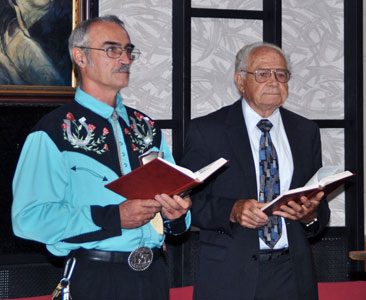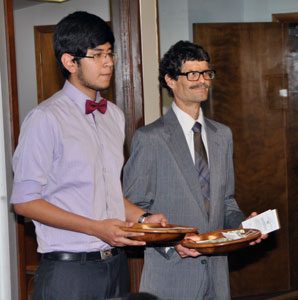
The Laurelbrook Seventh-day Adventist Church service on June 16, 2018 began with Rodney Herra welcoming everyone and making a few announcements.
Beth Brandt played an introit. The congregation had a silent invocation and then sang “Take Time to Be Holy”. Rodney Herra had the main prayer; the congregation responded with “Hear Our Prayer, O Lord”.
Rodney Herra then called for the offering. Hiram (2018 junior) and Clifton Brandt then collected the morning offerings; the loose offering went to the local church budget. The congregation sang the doxology, and Rodney Herra prayed for the offering.
Rodney Herra told the children a story about the children in his family picking berries along a railroad track. The other children heard the train and his older brother grabbed the wagon with Rodney in it and threw himself and the wagon off the track, the train missing them by just inches. His brother got banged up, sacrificing his comfort to save Rodney just as Jesus sacrificed himself for us.
Rodney Herra then read Judges 21:25 “In those days [there was] no king in Israel: every man did [that which was] right in his own eyes.”
Robert D. Zollinger discussed the topic “The Schools of the Prophets”. The congregation sang “We Know Not the Hour”. Robert D. Zollinger had the closing prayer.
Personnel Other Than Students:
Robert D. Zollinger - past president and board chairman of Laurelbrook
Rodney Herra - Laurelbrook church treasurer
Following are some notes on the sermon by Robert D. Zollinger:
- After Joshua, Israel was ruled by judges, the last judge being Samuel.
- [at this points, Mr. Bob pulled out a three-legged stool, an emblem of the schools of the prophets]
- God was unhappy with the way people were living. Solution? The schools of the prophets.
- Ellen White says that God wanted people trained to be prophets / teachers.
- 3 main concepts – educational setting centering on God’s laws / each student should learn to till the soil and a useful trade / health and healing were a part of the teaching.
- Everyone had to grow their own food and make their own living.
- Money coming in was reserved for the Levites and the priests.
- Ellen White says that health and healing were a part of the concepts students learned.
- In 1900 Ellen White returned to the U.S. because the Lord wanted her to spread the word on how our schools were to be run.
- Ellen White counseled that the Lord wanted the schools to train each student as a teacher briefly, to make sure everyone knows how to study the Bible, to make sure everyone is familiar with correct health principles and how to practice agriculture.
- These three principles are the three “legs” of the stool representing the correct way to run a school.
- Madison was established to embody these three principles.
- Elijah was a type of Christ.
- Every time we meet in the classroom the Holy Spirit is there. But many times the Spirit leaves due to a teacher’s disinterest in what He has to offer.
- Joshua 4:1-3 “1 ¶ And it came to pass, when all the people were clean passed over Jordan, that the LORD spake unto Joshua, saying, 2 Take you twelve men out of the people, out of every tribe a man, 3 And command ye them, saying, Take you hence out of the midst of Jordan, out of the place where the priests’ feet stood firm, twelve stones, and ye shall carry them over with you, and leave them in the lodging place, where ye shall lodge this night.”
- Joshua 4:19 “And the people came up out of Jordan on the tenth [day] of the first month, and encamped in Gilgal, in the east border of Jericho.” “Gilgal” means to “roll” or “roll over”. This was their first camp after the crossing of the Jordan.
- Gilgal was one of the main schools of the prophets, the site of Joshua’s altar.
- Laurelbrook is patterned after Madison. Madison was patterned after the schools of the prophets.
- The two pillars in the circle in front of the church were part of the Big House, the original building on the Laurelbrook property.
- 2 Kings 4:38-“38 ¶ And Elisha came again to Gilgal: and [there was] a dearth in the land; and the sons of the prophets [were] sitting before him: and he said unto his servant, Set on the great pot, and seethe pottage for the sons of the prophets. 39 And one went out into the field to gather herbs, and found a wild vine, and gathered thereof wild gourds his lap full, and came and shred [them] into the pot of pottage: for they knew [them] not. 40 So they poured out for the men to eat. And it came to pass, as they were eating of the pottage, that they cried out, and said, O [thou] man of God, [there is] death in the pot. And they could not eat [thereof].”
- Porridge is a symbol of spiritual food. They were learning from worldly sources.
- Meal is the substance used to make bread. The meal is symbolic of Jesus.
- The things we teach the students should be centered on the religious things God wants us to teach.
- 2 Kings 4:42-44 “42 And there came a man from Baalshalisha, and brought the man of God bread of the firstfruits, twenty loaves of barley, and full ears of corn in the husk thereof. And he said, Give unto the people, that they may eat. 43 And his servitor said, What, should I set this before an hundred men? He said again, Give the people, that they may eat: for thus saith the LORD, They shall eat, and shall leave [thereof]. 44 So he set [it] before them, and they did eat, and left [thereof], according to the word of the LORD.”
- Ellen White says in Prophets and Kings that people given a work from the Lord should not question whether there are sufficient resources to do it.
- Little Creek sent some students and teachers down to Laurelbrook to start a school. Mr. Bob went to Laurelbrook after his army stint to be in charge while the person in charge was gone.
- Little Creek decided that if they couldn’t take charge at Laurelbrook they would close the school. So they asked Mr. Bob to be that person at 22 years of age. The board wanted to set up a farm and a sanitarium, a place for sick people. But they didn’t know where they would get the money and the people to do this.
- The board with Mr. Bob walked out into the woods and put a spade into the ground where the front door of the sanitarium would be. Mr. Bob’s uncle drew up the plans after Mr. Bob sketched out the plans.
- Laurelbrook students and staff went out to help the neighbors with their truck farms. In turn, the neighbors gave them food.
- Mr. Blevins had a 100-acre farm in what is now the “bottoms”. Mr. Bob helped the couple fix their radio by plugging it in. So the couple let Laurelbrook pick wild blackberries on their property, the goal to can 100 gal. of blackberries every year.
- The Blevins house caught fire and burned to the group. The couple was brought back to Laurelbrook’s Big House. Mr. Blevins wanted the school to have their farm worth about $12,000.
- The board chairman and Mr. Bob offered $6000. The property price kept dropping until the property price met this goal. Mr. Blevins granted Laurelbrook two or three weeks to raise the money. The board chairman’s father-in-law donated money, and other friends chipped in to meet the need.
- The Lord wanted Laurelbrook to have an agricultural program. The same thing happened with the sanitarium (nursing home now).
- Mr. Bob took boys with shovels and picks and axes to start work on the sanitarium site. The Lord opened up ways to get the building built. A couple from Madison gave $46. Cinders for block making came from Dayton’s iron smelting plant. An old dump truck came from Little Creek. That 46 dollars went toward cement.
- They started making 30 blocks a day. But a random man walking through the woods guided them towards a block machine.
- This school is patterned after Madison and the schools of the prophets. Mrs. White’s counsel talks about the Madison School, which was after the schools of the prophets.

